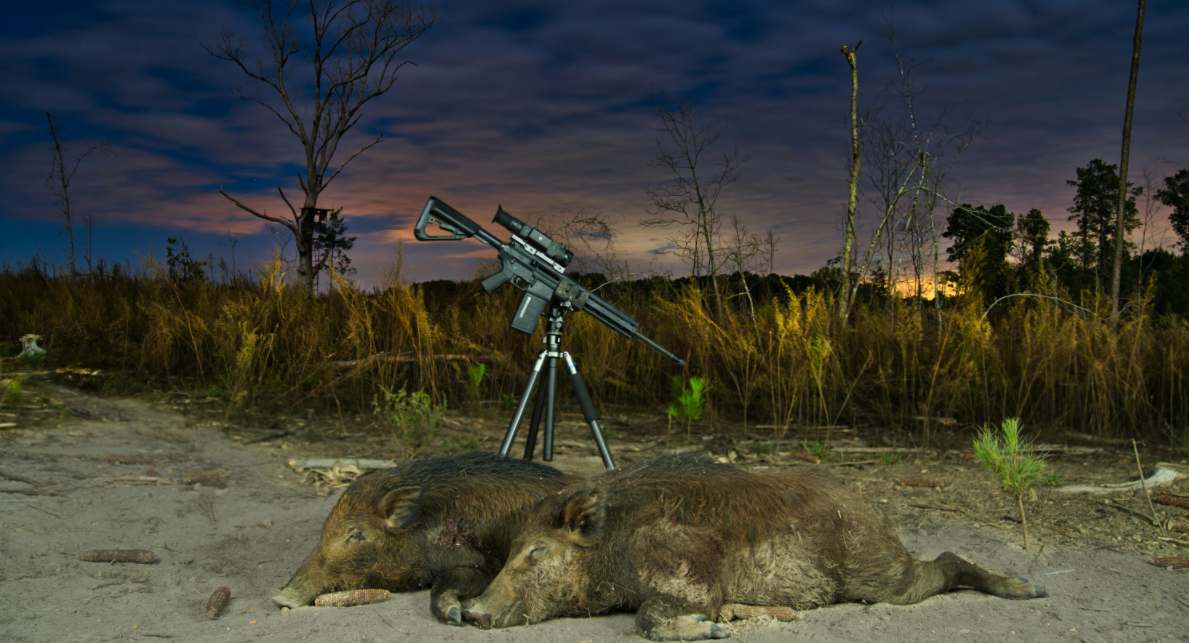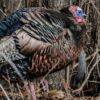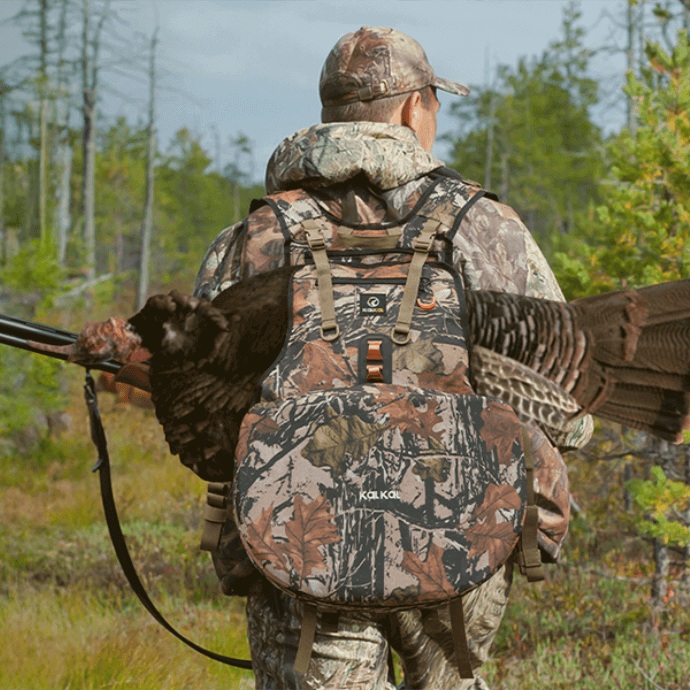Wild hogs are troublesome to many landowners because they destroy their property and spread diseases. So, hunting them is the best method of controlling the size of the population. However, when is the right time to go out there and have a successful hog hunt?
This guide focuses on the best time to hunt hogs, whether in the day or at night, as well as gear and tips for how to hunt hogs successfully.
When Is the Best Time to Hunt Hogs?
The ideal hunting periods are in the early morning and evening because hogs mostly move around during these times.
Whereas, during these cooler periods of the day, hogs become more active in search of feeds and more prone to moving around. This makes them more likely to encounter hunters and gives them a better chance of having an ethical hunt.
Best Season
During Winter, hogs may change their usual behavior and roam during the day in search of food since temperatures are low. This is especially the case because they require more energy due to the cold weather during winter and therefore have to look for more food.
Second, food resources may be limited in winter, requiring the hogs to strive more in search of food all over the range, during daytime.
Best Time of the Year
December to February is considered the prime time by many hunters for several reasons. First, deer season usually comes to a close in December or January with deer hunters being a determinant of daylight hog activity.
Second, as winter continues and food availability decreases in natural settings, the hogs may be foraging for new food sources and therefore are likely to be entering food plots or food feeders that are established by hunters.
Third, the cold weather provokes their increased appetite and makes them look for food more actively, which makes them more active in general.
Best Weather
- Rain: The hogs may roam during rain since it drives them out of their shelters and the ground becomes suitable for rooting.
- Dry weather: During dry months, hogs may move to the bottom portions of the island especially those with access to creeks.
Hunting Hogs In Daytime
Can you hunt hogs in the daytime?
Yes, you can hunt hogs during the day. While they’re naturally more active at dawn and dusk, there are ways to increase your chances of encountering them in daylight hours.
How to get hogs to come out in the daytime?
To attract hogs, there are several ways to do so:
- Feeders: Setting up timed feeders to dispense corn or other attractants in the early morning can train hogs to associate that area with food and encourage them to return during the day, especially if the food supply runs out quickly.
- Natural food sources: Locate areas with natural food sources like acorns, berries, or crops that hogs might be drawn to during the day. Setting up a blind nearby can increase your odds of spotting them.
- Weather: Cooler weather in winter can force hogs to forage more actively throughout the day to maintain energy levels. Rain showers can also push them out of hiding spots and make the ground easier for rooting.
What to pay attention to for daytime hunting?
- Sun position: Be mindful of the sun’s location to avoid casting shadows that might spook the hogs. Setting up a blind on the east side of a field in the morning or the west side in the evening can help with this.
- Wind direction: Hogs have a keen sense of smell. Pay close attention to wind direction and position yourself upwind from where you expect them to appear.
- Noise discipline: Hogs have good hearing too. Stay quiet while on the hunt and avoid making any unnecessary noise that could alert them to your presence.

Hunting Hogs At Night
Why night is favorable for hog hunting?
Hog Activity: Feral hogs are mainly active during the night period of the day. This means that they are most prolific during the night because they search for food and move from their resting and dining zones. It makes it possible to hunt them during those periods when they are most active.
Pressured Hogs: Large mature hogs while expecting high levels of hunting pressure during the day become very shy and are most active at night. Night hunting negates this learned behavior and presents an opportunity to meet them when they are least alert.
Feeder Targeting: When it comes to using feeders to lure hogs, nighttime has its perks. Hogs are familiar with artificial lights near the feeders, unlike the situation with daylight hunting.
Is it better to hunt hogs at night?
Whether night hunting is definitively “better” depends on the context of hunting, the intensity of the hunting trip, or the preferences of the hunters themselves.
Here’s a quick breakdown.
- Night is more productive when focusing on animals that feed during the night, especially if the hogs are pressured.
- Hunting during the day is also possible, especially in winter, or if feeders are used intentionally.
Challenges of night hunting for hogs
- Limited Visibility: This is the most significant problem. Always use quality artificial illumination devices such as scopes or thermal imagers to locate the hogs and guarantee ethical shooting.
- Spooking Hogs: Artificial lights can make hogs jumpy or nervous in one way or like sunlight. To avoid spooking them, you should strictly lower your lighting to red filters or low-powered lights. Also, respect noise control and avoid moving a lot when hunting for the animals.
- Shot Placement: One of the challenges of low light is that the shots when placed become a bit challenging. Make sure night shooting is ethical and practice before engaging in shooting at night.
Essential Equipment Needed For Hog Hunting
Below is the list of hunting gear that any hunter should carry with him for a hog hunting trip during the day or at night.
1. Firearm and Ammunition
- Choose a caliber appropriate for hogs. Common options include .223 Remington, .308 Winchester, or 12-gauge shotguns with buckshot slugs.
- Bring plenty of ammunition, keeping in mind that hogs are tough animals and follow-up shots might be necessary.
2. Clothing and Footwear
- Durable pants and boots: Protect your legs and feet from thorns, brush, and uneven terrain. Opt for snake boots if hunting in an area with venomous snakes.
- Weather-appropriate clothing: Dress in layers to adapt to changing temperatures, especially if hunting in the morning or evening.
- Hat and gloves: Provide warmth and protection from the elements.
3. Navigation and Communication
- Handheld GPS or compass and map: Always know your location and have a backup navigation system in case of electronics failure. You can download some hunting Apps for assistance.
- Two-way radios (optional): Communicate with your hunting party, especially important in low-light conditions or dense terrain. Or you can bring a cell phone. This can also be helpful for emergencies, but service may be limited in remote hunting areas.
9 Useful Tips For Hog Hunting
- Know your equipment: Make sure your firearm is properly sighted for correct shots, or that you’re familiar with safety in firing the weapon.
- Scout the area: Find out the presence of hog activity indicators such as footprints, wallowing areas, and rub lines.
- Hunt with the wind: One of the behaviors that hogs display is that they can smell. Move them downwind, where they will not be able to smell you. You can bring some milkweed for wind detection.
- Camouflage and cover: Hide yourself to prevent from disturbing the hogs. When observing the animals, use natural blinds or wear camouflage clothing.
- Shot placement: Shoot for the broadside (sideways) of the hog preferably near the shoulder area to minimize the suffering of the hog.
- Daylight: It is recommended that the hunting of the hogs be done early in the morning or late in the evening when they are most unstuffed.
- Nightlight: At night, it is advisable to use red filters or low-power lights to avoid frightening the hogs. Here we recommend Kalkal red light for hog hunting. A smart control light that offers visibility for hunters when hogs show up, and it will not spook the hogs.
- Be mindful of the weather: Weather seems to also influence how hogs move around in their environment. They become more active in cooler or rainy days.
- Use stand hunting or still hunting: These two types of methods are useful for hog hunting. Get covered on a stand or move quietly when looking for hogs. So you can spot or get closer to hogs without being detected.
- Patience and persistence: Hunting hogs can be fun but it can be tiring waiting for the animal to come to your site.
Conclusion
All in all, the best time to hunt hogs can be during the early morning and late evening but if done right during the day feeders, location and favorable weather conditions will do the job.
The benefits of night hunting include pressured boar and feeder targeting, but it has drawbacks such as the lack of visibility. But one thing remains the same; be safe, understand your tools, and be patient.
Thus, everyone interested in a successful and ethical hog hunt, should familiarize themselves with Hog’s behavior and apply the correct approach.





















Leave a reply